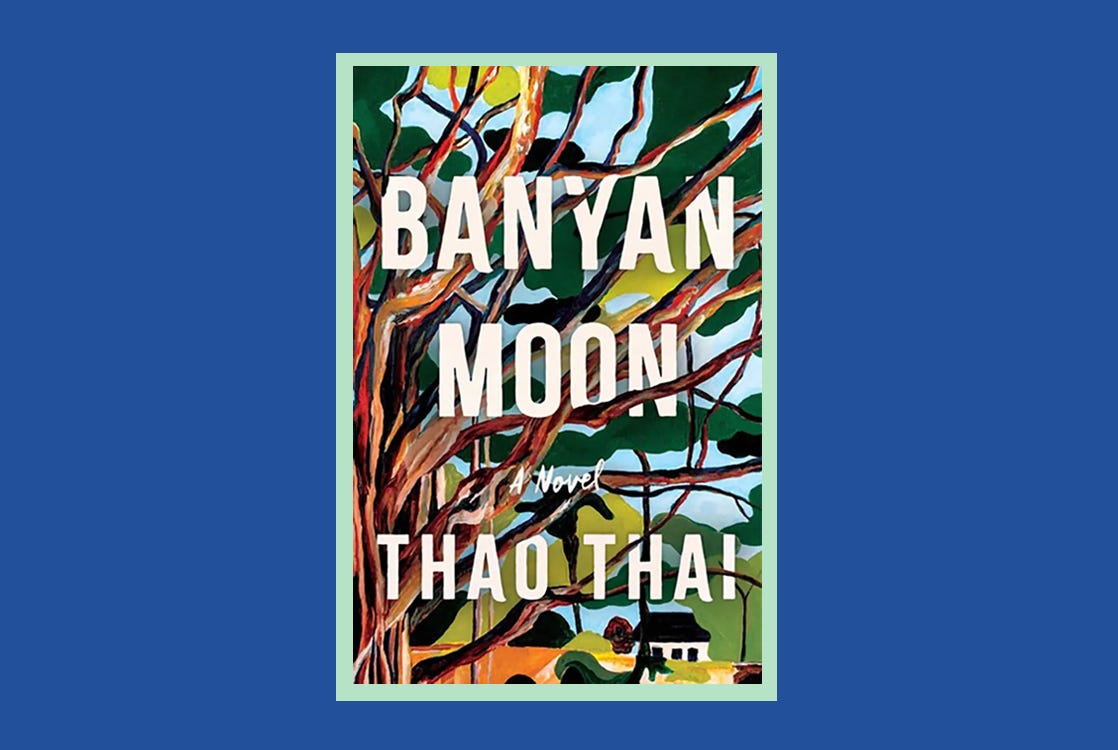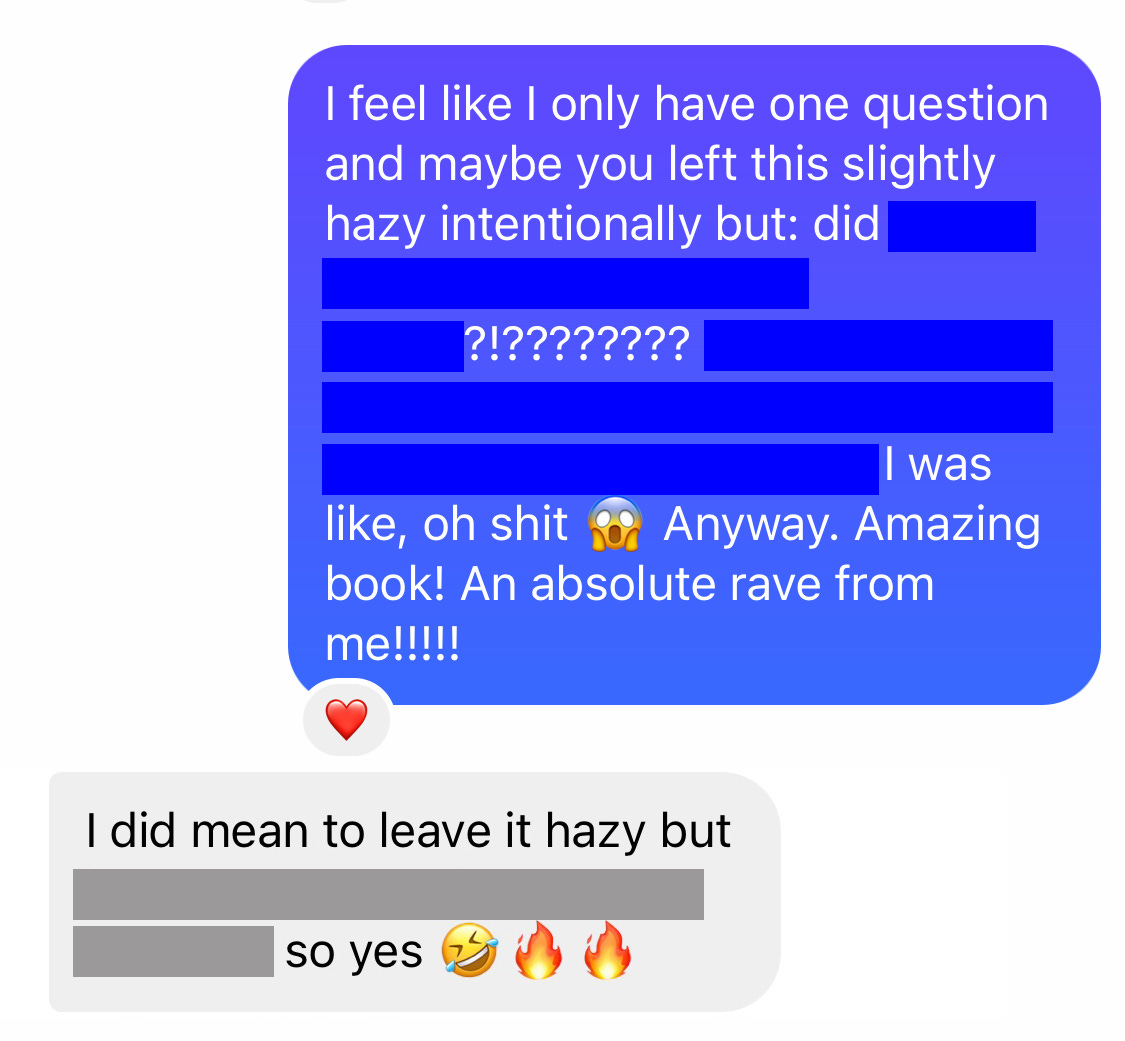Hey! Does anyone else feel like June is absolutely flying by??? I was going to publish this (free) issue next week, but decided it just couldn’t wait. THE book of the summer was released into the wild yesterday, and waiting a full week to scream about it from the rooftops just won’t do. So, please enjoy this issue about your next summer read, Banyan Moon, a week earlier than intended!! I’ll be back with an issue for paid subscribers next week. <3
I “met” Thao Thai over the internet in the summer of 2020 when she submitted this piece, “How Microaggressions Destroyed My Dream of Living in Suburbia,” to the cupcakes and cashmere blog for consideration.
(my friend and colleague) and I were both totally blown away by it; I definitely cried reading it the first time. I think my exact feedback was “holy fuck???” and I immediately fell in love with both Thao as a person, and with her work.Today I’m lucky enough to call Thao a friend, even if we’ve never met in person (we both live in the Midwest now, so someday we’ll change that!!). She sent me an advance copy of her debut novel this winter, and I remember basically screaming when I opened the box and saw the beautiful cover, which I’ve now seen what feels like hundreds of times after outlets like Book of The Month, Read With Jenna, and Downtime (formerly Girls’ Night In) all picked it up.
I read Banyan Moon in April just after the last winter storm hit St. Paul and the snow was finally melting to make way for spring. I devoured it in just a few sittings, then immediately sent Thao this DM:
I would describe Banyan Moon as so many things: beautifully written, emotional, intriguing, deep, mysterious. It’s a beautiful book about three women (mother, daughter, and grandmother) and their relationships with each other and the men in their lives. As Anna Kaplan wrote for The Today Show, “The book has three narrators — and one of them is a ghost.” This description kind of made me LOL, but it’s also totally accurate (but not in a creepy The Sixth Sense way; in more of a this-is-an-incredible-literary-device way).
While reading Banyan Moon, I was so invested in the stories of the Tran women that they genuinely felt like real people to me, which was not at all a surprise knowing this book was written by Thao, who can somehow make me cry just by writing about drinking coffee at her grandparent’s house. As someone who is super familiar with her short-form writing via publications like cupcakes and cashmere, Cup of Jo, and her newsletter,
, I loved that I could 1000% tell this book was written by Thao with the same flair for hauntingly beautiful language and emotional depth that appears in all of her work.Banyan Moon is told from the perspectives of three complicated, strong, imperfect women who carry a lot of secrets with them:
Ann: a Vietnamese-American illustrator who lives with her wealthy, white boyfriend in Michigan and grapples with a secret he’s been keeping (and what it means for her pregnancy)
Minh: Ann’s grandmother, who had a close relationship with Ann before she died, and narrates her chapters after her own death near the beginning of the novel
Hương: Ann’s mother, who is estranged from Ann until Minh’s death, and has always been envious of the close relationship between Ann and her mother
I honestly can’t/shouldn’t tell you much more about the plot (it’s about secrets, after all!!) but I did ask Thao a few spoiler-free questions for this issue about Banyan Moon and the process of writing her first book, below. I hope you enjoy!
Kelly: I have of course read the book (!!), but for anyone who hasn't yet, describe Banyan Moon in 10 words or less.
Thao: A multigenerational novel spanning continents, about secrets, inheritance, and motherhood.
Kelly: Where did the idea for Banyan Moon come from? Did it randomly come to you in the shower one day, or did you think about it for months/years before you landed on a concept?
Thao: I’ve been thinking about questions of motherhood for a long time, so in a way, Banyan Moon is a culmination of all these questions. But I first began circling around the idea for this novel through the image of Minh, the grandmother, viewing her own funeral from beyond the grave. I saw her watching the guests with her usual acerbic commentary, thinking about how her past has influenced the lives of her loved ones. She’s such an assertive (some might say domineering?) figure that I knew it would frustrate her not to be able to meddle in her daughter and granddaughter’s lives. She compelled me so much that I knew I had to chase that thread to the bigger story.
Kelly: Let's talk about your characters – I love them all, and your character development is so good. Are any of the characters based on people you know (or yourself?) How did you give them real personalities and then keep their motivations consistent?
Thao: Thank you, Kelly; I love them too! I don’t think anyone is based directly on anyone I know, but like all fiction, it’s more of a pastiche of different personalities I’ve encountered in my life. I thought a lot about both their personalities and the contexts they grew up in when I wrote the book. For example, Minh grapples with very different issues as a teenager during the Vietnam War than Ann, who lives in this very elite circle in the Midwest with her moneyed friends. Every step of the way, my editor and I would ask, “Is this something she would do? What’s the thinking behind this decision?” Writing rotating first-person point of views can be tricky, because you want to make the voices distinct yet realistic. It was important to me for readers to understand the characters’ motivations, even if they didn’t always agree or like those decisions!
Kelly: There's a lot of juicy stuff in your book–are any of the places or scenes in Banyan Moon drawn from your real life? (You don't have to go into detail...)
Thao: Oh, for sure! I was inspired by so much in my life, even if this book isn’t at all autobiographical. My family would tell me stories before going to sleep at night, the way Minh did for Ann, and many of the emotions around Minh’s time in the Vietnam War were inspired by their memories. And in terms of setting, I grew up in Florida, along the coasts, and I used to play among the banyan trees as a kid. They’ve always captured my imagination, so it felt like kismet when I stumbled upon the Vietnamese folklore of the banyan tree.
Kelly: I think sometimes we have this idea of writers writing their novels at a 200 year-old wooden desk in a cabin in the woods, on a typewriter, by candlelight. (Or is that just me?) What did the actual book-writing process look like for you? Where/how/when did you do a majority of your writing?
Thao: It’s not just you! While I would so love to be in a romantic setting like you describe (mine might be a beachside cottage), my writing set-up is far less glamorous! Think: ergonomic keyboard, back cushion, and footrest—getting older comes with a lot of gear! ;) But really, I’ll write anywhere. My emails and Notes apps are full of ideas, and whenever I have a sentence or image I want to capture, I’ll send it to myself from the bath, the carpool pickup line, wherever. While I wrote Banyan Moon, I was so lucky to have a partner who encouraged me to take time for my work, so I’d schedule overnight hotel stays where I could just plug in, caffeinate all night, and be in the zone.
Kelly: I don't know a lot about the editing process, but did the book change a lot from the original version to what ended up on shelves? How/why did Banyan Moon change from start to finish?
Thao: It did! My fabulous editor, Molly Gendell, and I really worked to ensure that all the women had equal time on the page (I had shortchanged Hương, the mother, in the first versions). We dove deep into the heart of the story and tried to consider the moments that were crucial to highlight, versus the ones that were peripheral and could be streamlined. It was a gift to collaborate with an editor who wanted to honor the story the way Molly did.
Kelly: Your essays and short form content are AMAZING. Why did you decide to write a full-length book? Was writing a book easier or harder than keeping up a consistent schedule of short-form essays?
Thao: Oh, thank you, Kelly; I feel the same about your essays! I began my creative writing journey as a fiction writer, but never felt I was “good enough,” whatever that means. My stories weren’t well received in my MFA workshops, and I lost a lot of my confidence, so I thought a novel was well out of reach. I actually quit writing for a decade after receiving my MFA! But after I became a mother and reevaluated a lot of my life choices, I realized that I’d been trying to write like other people (mostly white male authors who were worshiped in my classes) and not like myself—or the authors I loved to read. So I focused on finding my voice through my essays. Once I found my way back to the page, this novel poured out of me. In some ways, it was easier than essay writing, because I had all this momentum stored up … but I will say, I edit a lot more in fiction! I’m glad I found my way back into novels. It’s never too late :)
Kelly: What is one thing you think most people don't know about writing a book or becoming a published author?
Thao: That confidence is something you still have to earn—not with reviews or praise, but with a sense of self-belief that no one else can give you. I always thought I’d feel like I’d reached a milestone when I published a novel, and I do, but the external validation can’t really pierce anything unless you’ve summoned enough love for yourself. I know that sounds so cheesy! But there it is :)
Kelly: What are three books you think are similar-ish enough to your book in the way that if you loved those, you should read Banyan Moon?
Thao: Family Lore by Elizabeth Acevedo (out in August), The Turner House by Angela Flournoy, and Crying in H-Mart by Michelle Zauner.
Kelly: Who is your ideal reader for this book? Who do you hope it reaches?
Thao: I hope Banyan Moon gets picked up by readers who need to feel seen on the page. Those who have complicated relationships with their children or parents. Those who question their role in family legacies and churn against the expectations set forth by others. Love isn’t simple, and I hope my book can be a companion for anyone asking questions about their own relationships.
I had one more question for Thao about the ending of the book, which I actually asked her back in April and I won’t share fully because wow *spoilers* but it looked a little something like this:
A million congratulations to Thao on this amazing thing she just did. Banyan Moon is now available anywhere you buy your books! Don’t forget to check out Leslie’s interview with Thao (it’s really really good) and The New York Times review by Kayla Maiuri, too.
K bye,
Kelly







